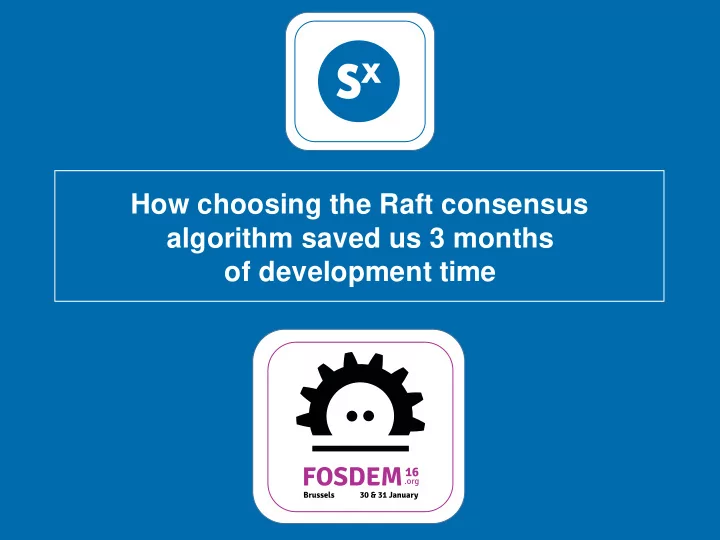

How choosing the Raft consensus algorithm saved us 3 months of development time
What do I do with unused space on my servers?
Let’s build an S3 cluster! Requirements: • Fully S3 compatible • Easy to maintain • Fault tolerant
I found a great candidate: SX + LibreS3 Bonuses: • Block level deduplication + • Highly scalable • Multiplatform … but something was missing!
What about automatic failover? Almost there! • Fully distributed • Data replication • Cluster membership management ... but no support for detecting and kicking out dead nodes
How to deal with the failure? • Some node has to make a decision • Decisive node must not be faulty • All the alive nodes should follow There is a need for a consensus algorithm.
Choosing the algorithm Paxos: Raft: • Proven to work • Easy • Very complicated • Straightforward • Many variants and implementation • Accurate and interpretations (ZooKeeper, …) comprehensive specs And the winner is… Raft!
Raft How does it work?
Leader election
Leader election
Leader election
Leader election
Raft Node failure
Dead node detection
Dead node detection
Dead node detection
How I implemented Raft in SX
Implementation details • Heartbeats are sent via internal SX communication • Membership changes are performed automatically • Node failure detection relies on configurable timeouts • Almost no impact on SX performance
How to enable Raft in SX? Enable Raft node failure timeout: $ sxadm cluster --set-param hb_deadtime=120 \ sx://admin@sx.foo.com Kill one of the nodes and check its status: $ sxadm cluster – I sx://admin@sx.foo.com * node 10…da : … status: follower, online: ** NO ** * node bd …ad : … status: follower, online: yes * node c2…b7 : … status: leader, online: yes Wait for the node to be marked as faulty: $ sxadm cluster – I sx://admin@sx.foo.com * node 10…da: … status: follower, online: ** FAULTY ** * node bd …ad: … status: follower, online: yes * node c2…b7: … status: leader, online: yes
www.skylable.com Robert Wojciechowski follow @skylable
Stay tuned …
Coming up next: SXFS FUSE based filesystem mapping for SX: • Client-side encrypted • Fully deniable • Deduplication • Fault tolerant
The election basics • There is only one legitimate leader • Each node chooses a timeout • When timeout is reached a new election is started • A candidate node votes for itself • The candidate requests a vote • In case the candidate received a majority of votes it becomes a new leader
Corner cases Leader failure
Leader node failure
Leader node failure
Leader node failure
Leader node failure
Corner cases Race condition
Election race condition
Election race condition
Election race condition
Election race condition
Corner cases Split votes
Split votes
Split votes
Split votes
Split votes
Recommend
More recommend